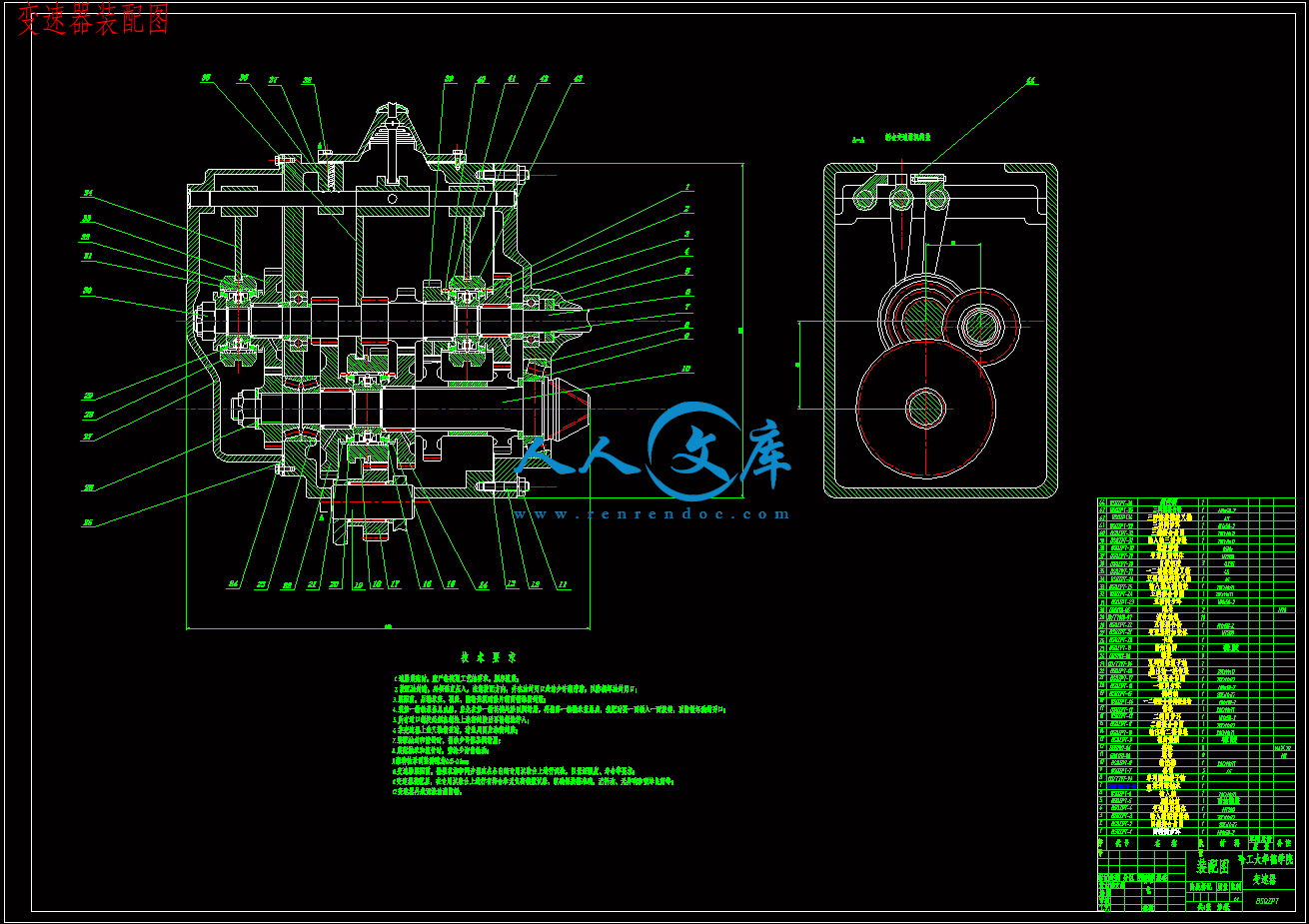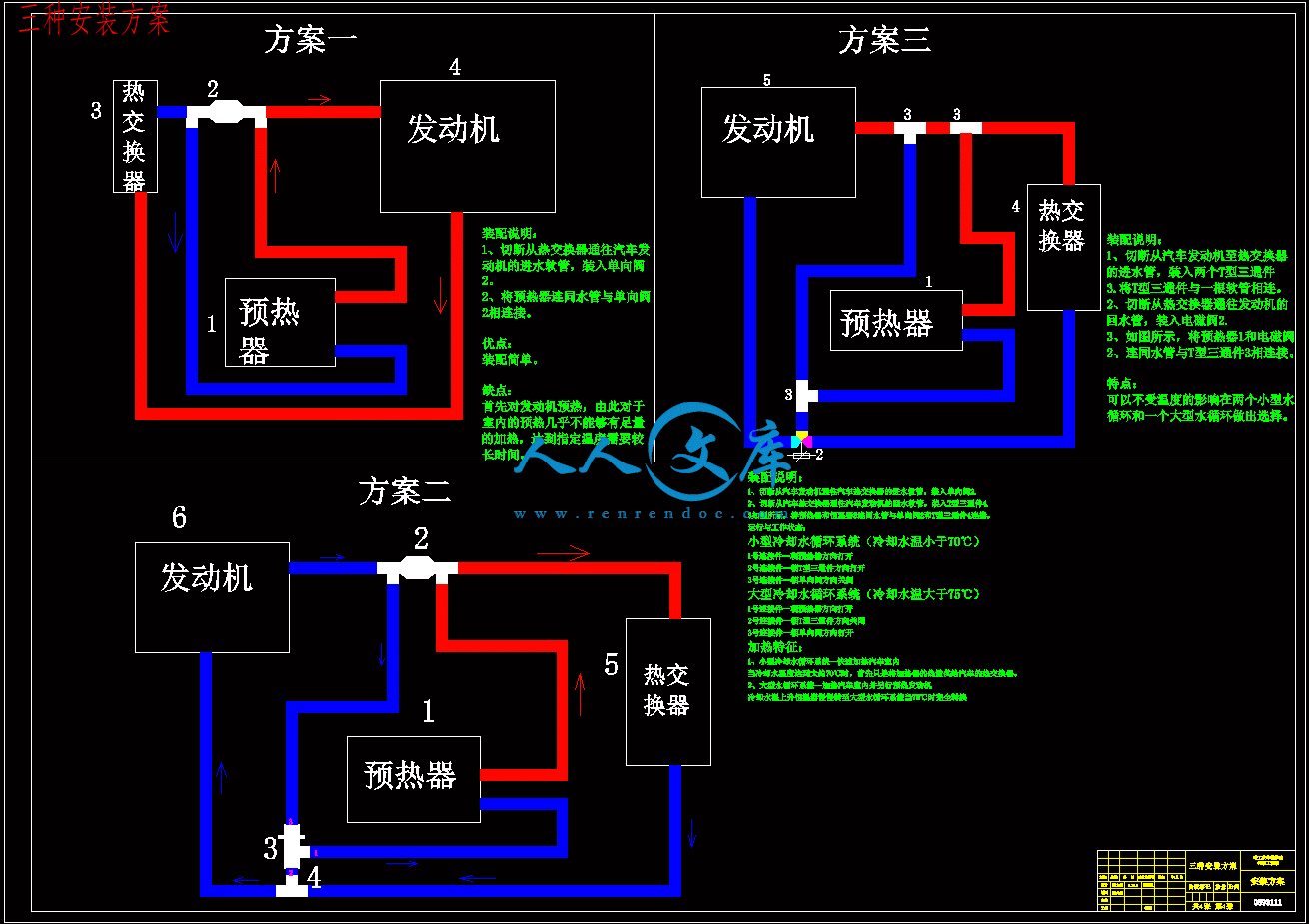丹东黄海客车独立采暖系统设计
44页 22000字数+说明书+任务书+7张CAD图纸
三种安装方案.dwg
中文摘要.doc
丹东黄海客车独立采暖系统总图.dwg
丹东黄海客车独立采暖系统设计论文.doc
任务书.doc
几种热交换器的改进方案.dwg
前封面模版.doc
变速器装配图.dwg
热交换体.dwg
英文摘要.doc
论文.pdf
输入轴.dwg
输入轴一档齿轮.dwg
目 录
摘要 Ⅰ
Abstract Ⅱ
第1章 绪论1
11 课题研究前景1
12 国内外研究现状1
121 国外加热器研究现状2
122 国内加热器研究现状3
123 国内外的技术差距4
13 课题研究主要内容5
第 2 章 车用加热器简介6
21 车用加热器工作原理6
22 车用加热器的分类 8
23 车用加热器的用途 9
24 加热器在汽车上的安装11
25 加热器的发展趋势 11
第 3 章 黄海客车加热器功率的匹配计算13
31 车内空气升温所需加热器的功率13
311 一般车辆加热器功率的计算方法13
312 汽车加热器功率的计算方法14
313 车窗玻璃散热量15
314 车壁散热量16
315 室内空气温升所需热量16
316 小结17
32 发动机冷起动斫需加热器的功率17
33 加热器功率的确定18
34 冷起动所需时间的计算和验证18
35 本章小结19
第4章加热器燃烧室配风及水泵、油泵的选取20
41 燃烧室配风原则20
42 燃烧稳焰原理及措施20
43 助燃空气调整21
44 水泵的选择原则22
45 油泵的选取原则22
46 本章小结23
第5章喷油嘴参数确定及点火方式分析24
51 喷油嘴的几种类型24
52不同喷油嘴的性能对比24
53不同喷油椎体、喷油椎角对比25
54点火方式分析26
55本章小结27
第6章 燃烧污染物的生成机理及防护措施28
61主要污染物及危害28
62污染物生成机理28
621 HC 生成机理29
622 CO 生成机理29
623 NOx 生成机理30
624 炭烟生成机理31
63 污染物减排措施31
64 本章小结32
第7章车用加热器的改进与提高33
71 尾气换热器33
72 尾气换热器的设计方案33
73 尾气换热器对加热器产生的影响分析34
74 换热管的设计与改进分析34
75 本章小结35
第8章结论36
致谢38
参考文献39
摘 要
预热器是随着汽车行业的迅速发展而演变出来的产物(也称为加热器下文均称为加热器),为了能够低温条件下发动机冷起动,车厢供暖,挡风玻璃除霜,减少发动机的磨损,降低燃油消耗率,增加发动机的工作效率和使用寿命,加热器便由此产生了。
喷射雾化式加热器由于燃油跟空气混合充分,燃烧完全,热效率高,有害排放少,所以本次设计研究喷雾雾化加热器用来满足丹东黄海客车加热的需要。针对目前国内使用较多的YJP.Q系列喷射雾化式液体燃油加热器进行了性能摸底调研,掌握了其基本工作规律,并对其进行了相应的改进提高。
根据市场需求在现有技术和产品的基础上对YJP.Q系列燃油加热器进行了各系统尺寸的优化设计。调研发现:燃烧筒在一定长度范围内长度越长,加热器热功率、热效率越高;而小筒则在一定长度范围内长度越短,加热器热功率、热效率越高;存在一最佳尺寸锥形罩使加热器热功率、热效率最高;燃烧筒和小筒的双层燃烧室设计起到了很好的防止通过热辐射使热量流失的作用;
目前大多数液体型燃油加热器均采用螺旋式水腔进行换热,因该类换热器的换热面积受到制约,故热量损失较大。针对现有燃油加热器热交换器所存在的不足,充分的利用所学的知识,联系自己的想法设计了一种换热效率更高的带换热管的燃油加热器用热交换器。此热交换器的换热管位于燃烧器火焰筒中,一方面可以增加加热器的换热面积,充分吸收高温燃气的热能;另一方面,由于换热管直接与燃烧火焰接触,会在管内产生泡态沸腾,从而强化换热,提高加热器整体的热效率。此外,还设计了一系列新型的尾气换热器,充分利用加热器的尾气提前对换热水进行加热,明显提高了加热器的功率、效率,降低了排放。
关键词:车用加热器;换热管;尾气换热器;改进提高
Abstract
Preheater, with the rapid development of automobile industry evolved out of the product (hereinafter referred to as the heater is also known as the heater), in order to be able to cold start the engine under low temperature conditions, car heating, defrosting the windshield, reducing engine wear and reduce fuel consumption and increase engine efficiency and service life, resulting in the heater will. As the fuel jet atomization heater air mix with the full, complete combustion, thermal efficiency, less harmful emissions, so this study nebulizer heater designed to meet the heating needs of Dandong Huanghai Bus. For domestic use more YJP. Q series jet atomizing liquid fuel heater performance thoroughly research, mastered the basic work rules, and its corresponding improvement increase.According to market demand in existing technologies and products based on the YJP. Q-Series fuel heater were optimized design of the system size. Research found that: the length of the combustion tube in a certain range the longer the heater thermal power, thermal efficiency is higher; and small tube in a certain length within the length of the shorter heater thermal power, thermal efficiency is higher; there is a best size conical cover so that the heater thermal power, thermal efficiency up to; combustion tube and small tube of double-chamber design has played a very good to prevent heat loss by thermal radiation to the role;
Most liquid-type fuel heaters are used spiral water chamber heat exchanger, heat exchanger for heat transfer of such restricted area, so the heat losses. Existing oil heater heat exchangers for the shortcomings, full use of the knowledge learned, our own ideas designed a more efficient heat transfer tubes of the fuel heater with heat exchangers. This heat exchanger tubes in the burner flame tube in one hand, the heater can increase the heat transfer area, high-temperature gas absorb heat; the other hand, direct heat exchange contact with flame, will produce bubbles in the pipe state boiling, and thus enhanced heat transfer, improving the overall thermal efficiency of the heater. In addition, also designed a series of new exhaust gas heat exchanger, full use of advanced exhaust gas heater for hot water for heating, significantly increased heater power, efficiency and reduce emissions.
Key words: Car heater; Tubes; exhaust gas heat exchanger; Improvements to improve
1.3 课题主要研究内容
本设计基于河北宏业YJP-Q系列燃油加热器为研究对象。首先对加热器进行了原理分析,并对黄海客车车厢热负荷计算合理匹配加热器,以摸清这些因素对加热器性能的影响,合理选择水泵、高压油泵、合理的进风量,然后对加热器进行了尺寸调研分析,换热管的方案分析;设计了不同规格的尾气换热器并进行了试验;对不同情况的加热器安装方案进行分析;对油嘴分别进行了不同喷油角度、不同喷油锥体、不同喷油量的分析,优化它们对加热器性能的最佳影响情况。最后对加热器所产生的燃烧污染物进行分析处理提出建议。第3章 黄海客车加热器功率的匹配计算
随着汽车工业的发展和人民生活水平的提高,为解决冬季汽车发动机的冷起动和司乘人员的取暖问题,降低起动与暖机过程中的排放,实现车窗除霜、车内取暖,目前加装独立式燃油加热器的车辆越来越多。如何给车辆匹配一台合适的加热器,是我们首先考虑的问题。
3.1 车内空气升温所需加热器的功率
当环境温度较低,车辆发动机的余热不能满足取暖空间的要求时,需要汽车加热器为车辆提供热能,以保证车内合适的温度。下面为丹东黄海某车型参数(表3.1),确定加热器功率的计算方法。
表3.1 丹东黄海客车技术参数
丹东黄海客车
项 目 单 位 指 标
外形尺寸mm7990×2350×3240
轴距mm3800
额定乘员(含驾驶员)人19~33
车厢内高mm1920
最高车速Km/h
发动机型号YC4112ZLQ
额定功率kw/r132/230
最大扭矩Nm/r660/1400
噪声dB115
质量Kg400
3.1.1 一般车辆加热器功率的计算方法
按交通部JT/T325-2002《营运客车类型划分及等级评定》,乘客人均采暖量>1880千焦/小时。
丹东黄海客车额定乘员(含驾驶员)19-33人,则所需加热器发热量Qmax=33×1880=62040千焦/小时=17.2kW。





 川公网安备: 51019002004831号
川公网安备: 51019002004831号